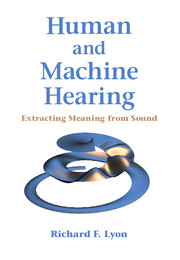Book contents
- Frontmatter
- Dedication
- Contents
- Foreword
- Preface
- Part I Sound Analysis and Representation Overview
- Part II Systems Theory for Hearing
- Part III The Auditory Periphery
- 13 Auditory Filter Models
- 14 Modeling the Cochlea
- 15 The CARFAC Digital Cochlear Model
- 16 The Cascade of Asymmetric Resonators
- 17 The Outer Hair Cell
- 18 The Inner Hair Cell
- 19 The AGC Loop Filter
- Part IV The Auditory Nervous System
- Part V Learning and Applications
- Bibliography
- Author Index
- Subject Index
- Plate section
17 - The Outer Hair Cell
from Part III - The Auditory Periphery
Published online by Cambridge University Press: 28 April 2017
- Frontmatter
- Dedication
- Contents
- Foreword
- Preface
- Part I Sound Analysis and Representation Overview
- Part II Systems Theory for Hearing
- Part III The Auditory Periphery
- 13 Auditory Filter Models
- 14 Modeling the Cochlea
- 15 The CARFAC Digital Cochlear Model
- 16 The Cascade of Asymmetric Resonators
- 17 The Outer Hair Cell
- 18 The Inner Hair Cell
- 19 The AGC Loop Filter
- Part IV The Auditory Nervous System
- Part V Learning and Applications
- Bibliography
- Author Index
- Subject Index
- Plate section
Summary
The CA (cochlear amplifier) model explains the detection of small differences in time as well as in frequency, the dual character of the electrocochleogram, recruitment of loudness in cochlear hearing impairment, the long latency of normal neural responses near threshold, acoustic emissions (both stimulated and spontaneous) and the locus of TTS (temporary threshold shift) in the frequency range above the exposure tone. Both the classical high-intensity system and the active low-level CA system are highly nonlinear and they combine to compress the great dynamic range of hearing into a much narrower range of mechanical movement of the cilia of the inner hair cells.
—“An active process in cochlear mechanics,” Hallowell Davis (1983)To model the active and compressive amplifying wave propagation in the cochlea, the CARFAC stage incorporates dynamic nonlinearity or fast acting compression (FAC) through a structure we call the digital outer hair cell (DOHC), shown in Figure 17.1. This structure varies the positions of the poles and zeros, changing their radius r in the z plane by changing r in the coefficient formulas. The r value is increased from its passive value, where it would be for very loud sounds, to actively reduce damping for weaker sounds. Alternatively, we may say that the r value is decreased in response to sound, from its maximum value in quiet, down to a minimum or passive value.
Compression of a wide input dynamic range, by controlling the amplification of lowlevel sounds, is the primary function of this component, which is unique to the mammalian auditory system. The distortion that the OHC generates as an inevitable byproduct of varying the gain is useful as a diagnostic, both for humans and for machine models. The distortion products are sometimes audible, contributing to perceptual differences between sounds.
The cell-membrane protein channel that makes outer hair cells work as active “motors” is known as prestin. Species with good high-frequency echolocation capabilities—bats and dolphins—exhibit an interesting convergent evolution of their prestin genes, presumably in support of good high-frequency amplification of feeble echos (Li et al., 2010).
- Type
- Chapter
- Information
- Human and Machine HearingExtracting Meaning from Sound, pp. 309 - 319Publisher: Cambridge University PressPrint publication year: 2017



